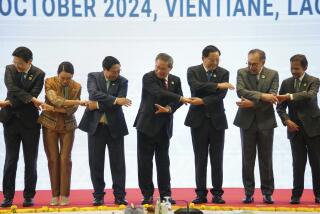Good--and Bad--Times for ASEAN
- Share via
SINGAPORE — There was good news and bad news Saturday as the leaders of Southeast Asia’s 10 countries concluded their annual two-day summit amid signs of China’s growing regional influence and a shared desire to speed the pace of e-commerce and information technology.
The good news was that the gloom of the 1997-98 economic crisis had lifted. Though stock markets and currencies are down, most states have rebuilt their foreign-exchange reserves and are enjoying plump current-account surpluses. The leadership is again looking to the future--discussing an East Asian free-trade zone to include China, Japan and South Korea, the construction of a $2-billion rail line from Singapore to China, and massive investment in technology.
The bad news was that, at least partly because of economic reasons, the Assn. of Southeast Asian Nations, or ASEAN, is embroiled in turmoil that has put the jobs of some prime ministers and presidents in jeopardy and increased investor concern over the future of what, throughout much of the 1990s, was the world’s fast-growing economic region.
Philippine President Joseph Estrada goes on trial Dec. 7 after being impeached for corruption. Indonesian President Abdurrahman Wahid, an ailing, legally blind Muslim cleric, has proved himself so incompetent that his own press secretary describes him as offering his nation “a good heart but not much else.” Thai Prime Minister Chuan Leekpai is running a distant second in polls for the Jan. 7 national election.
Then there is Cambodian Prime Minister Hun Sen. Eighty gunmen with unclear political goals tried to take over Cambodia’s capital, Phnom Penh, Friday morning. Police shot at least seven men to death and have arrested more than 50 suspects.
And there’s Sultan Sir Hassanal Bolkiah of oil-rich Brunei. His younger brother, Prince Jefri, accused of siphoning $26 billion in state funds, reached an out-of-court settlement with the government in May and had to hand over all the hotels, land and office buildings he had accumulated around the world.
Insurgency in Laos, Abuses in Myanmar
In Laos, a low-level rebel insurgency and the explosion of bombs in the capital threaten stability. In Myanmar, the ruling generals continue to draw international criticism for human rights abuses that include forced labor.
“Maybe some of the current problems were triggered by the economic crisis,” said Bruce Gale, a Singaporean-based political risk consultant, “but I’d argue that the crisis exacerbated existing problems--corruption, financial mismanagement, dictatorial governments--and thereby accelerated the pace of change that would probably have taken place anyway, such as demands for democracy and greater transparency in business and government.”
Gale and others say the situation has been made worse by investors’ shift away from Southeast Asia and toward Northeast Asia. Sixty percent of foreign investment in emerging Asian economies this year ended up in China, economists say, and the nation’s pending entry into the World Trade Organization seems likely to divert even more investment northward.
China Offers Aid for Infrastructure
At the summit here, Chinese Premier Zhu Rongji went to lengths to assure leaders that Beijing did not seek to dominate Southeast Asia but was committed to playing a larger role in the global economy. He offered China’s assistance in improving the region’s infrastructure, such as dredging the Mekong River to open shipping lanes and helping build sections of the trans-Asian rail line.
“China will push forward its modernization drive in all areas on a new basis and a larger scale,” he said. “We will unswervingly open still wider to the outside world.”
ASEAN leaders remain uneasy about China’s growing economic and military power but endorsed plans Saturday to consider closer cooperation with Beijing. “The relationship between Southeast and Northeast Asia is kind of a competitive thing,” ASEAN Secretary-General Rodolfo C. Severino Jr. said in an interview. “But there is great potential for closer collaboration that will benefit both regions.”
Some analysts see China’s increased influence coming at the expense of the United States, which provides 60% of ASEAN’s imports. ASEAN’s 10 members combined have a population of 500 million, a gross domestic product of $737 billion and total trade of $720 billion.
Prime Minister Goh Chok Tong of Singapore said, however, that the idea of bringing East Asia together in free-trade and investment zones--an idea ASEAN set up a study group to explore--was about “open regionalism” and was not an attempt to exclude the United States, Southeast Asia’s dominant non-Asian economic and military power.
“We need the United States to be in East Asia,” he told the summit. “This is not an attempt to shut out Washington from Asia.”
At the summit, ASEAN leaders also signed an e-commerce accord that calls for establishment of high-speed regional Internet connections and eventual elimination of duties on related goods and services.
The 10 ASEAN members are Thailand, Singapore, Malaysia, Indonesia, Brunei, the Philippines, Vietnam, Cambodia, Laos and Myanmar, formerly Burma.
More to Read
Sign up for Essential California
The most important California stories and recommendations in your inbox every morning.
You may occasionally receive promotional content from the Los Angeles Times.













